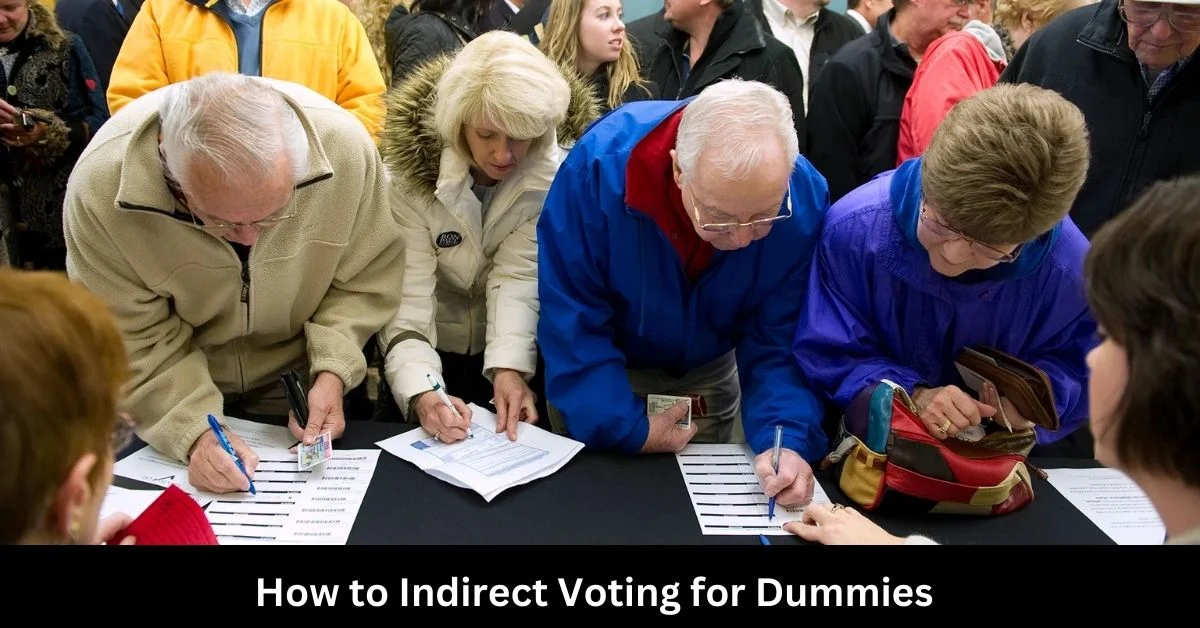Understanding the concept of Indirect voting for Dummies can be perplexing for many, especially in democracies where the direct election of leaders is more common. Indirect voting, however, is a vital part of many political systems around the world, including presidential elections in countries like the United States. This article seeks to demystify Indirect voting for Dummies by explaining its mechanisms, history, advantages, disadvantages, and how it impacts various political structures. By the end of this guide, you’ll have a clearer understanding of how indirect voting works and why it remains relevant in modern politics.
What Is Indirect Voting?
Indirect voting refers to a process where voters do not directly elect a candidate for a particular office. Instead, they elect representatives, who in turn make the final decision on who will assume that office. This method is most famously associated with the United States Electoral College system but is used in various other countries and settings as well.
In direct elections, voters cast their ballots for the individual they want to hold office. In indirect voting, however, voters are not directly choosing the officeholder; instead, they are selecting intermediaries who will vote on their behalf. These intermediaries are typically representatives, delegates, or electors.
Key Features of Indirect Voting
- Representative voting: Instead of directly electing officials, voters elect representatives who make the final decision.
- Multiple layers of decision-making: The decision-making process includes an intermediary body or individual between the voters and the final election result.
- Common in certain political systems: Indirect voting is used in parliamentary systems, presidential elections in some countries, and certain non-political organisations such as corporate boards.
Historical Context of Indirect Voting
Indirect voting is not a new concept. Its origins can be traced back to ancient civilizations, where governing bodies or councils made decisions on behalf of the populace. In fact, indirect voting is deeply embedded in the democratic tradition, serving as a compromise between direct democracy and the complexities of managing large populations.
The Founding Fathers and the Electoral College
In the United States, the founding fathers feared direct democracy, believing that the general populace might not always be well-informed or capable of making the best decisions in electing national leaders. As a result, they established the Electoral College during the drafting of the Constitution in 1787. This system allowed citizens to vote for electors, who would then vote for the president and vice president.
The idea behind this was to create a buffer between the popular vote and the final election of the president, ensuring that a group of more informed individuals had the ultimate say in electing the nation’s leader. While controversial, the system persists to this day and continues to stir debate.
Other Examples of Indirect Voting
Indirect voting is not unique to the United States. Many other countries employ it in different forms:
- Germany: In Germany, the Chancellor is elected indirectly. Citizens vote for members of the Bundestag, who then elect the Chancellor.
- India: The President of India is chosen indirectly by an electoral college made up of members of parliament and legislative assemblies.
- United Kingdom: The Prime Minister is not directly elected by the public. Instead, citizens vote for Members of Parliament (MPs), and the leader of the majority party becomes the Prime Minister.
How Indirect Voting Works: A Step-by-Step Breakdown
Step 1: Voters Elect Representatives
In an Indirect voting for Dummies system, the first step involves citizens casting their ballots to elect representatives. These representatives could be members of a legislature, delegates, or electors. The key point is that these intermediaries are chosen by popular vote.
For example, in the U.S. presidential election, voters don’t directly choose the president; they elect electors, who then vote for the president in the Electoral College. In parliamentary systems, voters elect members of the parliament, who will then choose the head of government, such as a prime minister.
Step 2: Representatives Make the Final Decision
Also Read: Ein Hoch auf Chilaquiles: A Mexico’s Beloved Breakfast Dish
Once the representatives are chosen, they convene in a formal process to make the final election decision. These representatives may be bound by the voters’ preferences or have discretion in their choice, depending on the rules of the system.
In some cases, such as the U.S. Electoral College, electors are expected to vote for the candidate who won the popular vote in their state, but there have been instances of “faithless electors” who vote against the state’s choice. In parliamentary systems, the decision of who becomes the head of government is often influenced by party dynamics and negotiations.
Step 3: The Election Result Is Announced
Once the representatives have made their choice, the result is announced, and the elected official assumes office. In presidential systems like the U.S., the decision by the electors is final, and the president is inaugurated shortly thereafter. In parliamentary systems, the head of government is appointed once the legislative body has completed its voting process.
Advantages of Indirect Voting
1. Checks and Balances
Indirect voting systems can provide a safeguard against the potential risks of direct democracy. For example, in the U.S., the Electoral College was created to prevent the possibility of an ill-informed public choosing an unqualified candidate. The representatives or electors serve as a layer of oversight, ideally ensuring that the final decision is well-considered.
2. Representation of Diverse Interests
In countries with indirect voting, the system can ensure that regional or minority interests are represented in the decision-making process. In the U.S., smaller states have greater representation per capita in the Electoral College, which helps balance the power between populous and less populous regions. In parliamentary systems, smaller political parties can sometimes play a key role in coalition governments, giving them more influence than they might have in a purely direct voting system.
3. Encourages Stability
Indirect voting systems, especially in parliamentary democracies, can promote political stability. Since the head of government is usually elected by a majority in the legislature, it often ensures that the government has a stable backing in the lawmaking body. This can prevent gridlock and create a government that is more effective at passing legislation.
Disadvantages of Indirect Voting
1. Discrepancy Between Popular Vote and Election Outcome
One of the most significant criticisms of indirect voting is the possibility that the outcome may not reflect the popular vote. For example, in the U.S. presidential elections, it is possible for a candidate to win the Electoral College while losing the popular vote, as happened in the 2000 and 2016 elections. This discrepancy can lead to questions of legitimacy and undermine confidence in the electoral process.
2. Complexity and Lack of Transparency
Indirect voting systems can be more complicated than direct voting systems, leading to confusion among the electorate. Voters may not fully understand how their vote translates into the final result, especially when the process involves multiple layers of decision-making. This lack of transparency can alienate voters and diminish the perceived fairness of the election.
3. Potential for Manipulation
The intermediaries in an indirect voting system, such as electors or representatives, can sometimes act against the will of the people. In the U.S., for instance, “faithless electors” have occasionally voted for candidates other than the ones they were pledged to support. While rare, such actions can cause significant controversy and undermine trust in the electoral process.
Indirect Voting in Non-Political Settings
Indirect voting isn’t limited to political elections; it’s also common in corporate governance and other organisations. For example, in many companies, shareholders don’t directly elect the CEO. Instead, they elect a board of directors, which in turn appoints the CEO. Similarly, in large non-governmental organisations or unions, members may elect delegates who represent them in decision-making bodies.
In these contexts, indirect voting is often used because it simplifies decision-making in large organisations. Instead of thousands of shareholders or members voting on every major decision, they elect representatives to make those choices on their behalf. This delegation of authority allows for more efficient governance while still maintaining a degree of accountability to the broader membership.
The Future of Indirect Voting
As political systems evolve and the world becomes more interconnected, the debate over the merits of indirect voting continues. Some advocate for reforms to make elections more direct, such as eliminating the Electoral College in the U.S., while others argue that indirect systems provide necessary checks on the will of the majority.
Technological advancements, such as blockchain-based voting systems, may offer new ways to blend the benefits of direct and indirect voting. For example, some proposals suggest using technology to create more transparent and secure indirect voting processes, ensuring that representatives remain accountable to the voters who elected them.
At the same time, indirect voting is likely to persist in various forms, especially in parliamentary systems and non-political organisations. Its ability to balance competing interests, provide stability, and serve as a check on the excesses of direct democracy ensures that it will remain a feature of many decision-making processes worldwide.
Conclusion
Indirect voting for Dummies is a complex but essential part of many political and organisational systems. While it has its advantages, such as providing checks and balances and representing diverse interests, it also has significant drawbacks, including the potential for discrepancies between the popular vote and the final outcome. Understanding how indirect voting works and the role it plays in various contexts is crucial for anyone interested in the functioning of democratic systems. By grasping the nuances of this process, voters can better appreciate the strengths and weaknesses of the systems that govern them.
Read More: Remembering the Balmain Obituaries in Atwood






